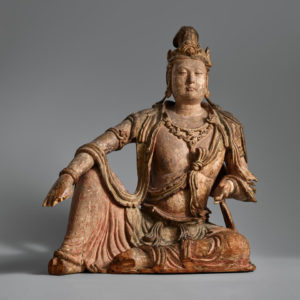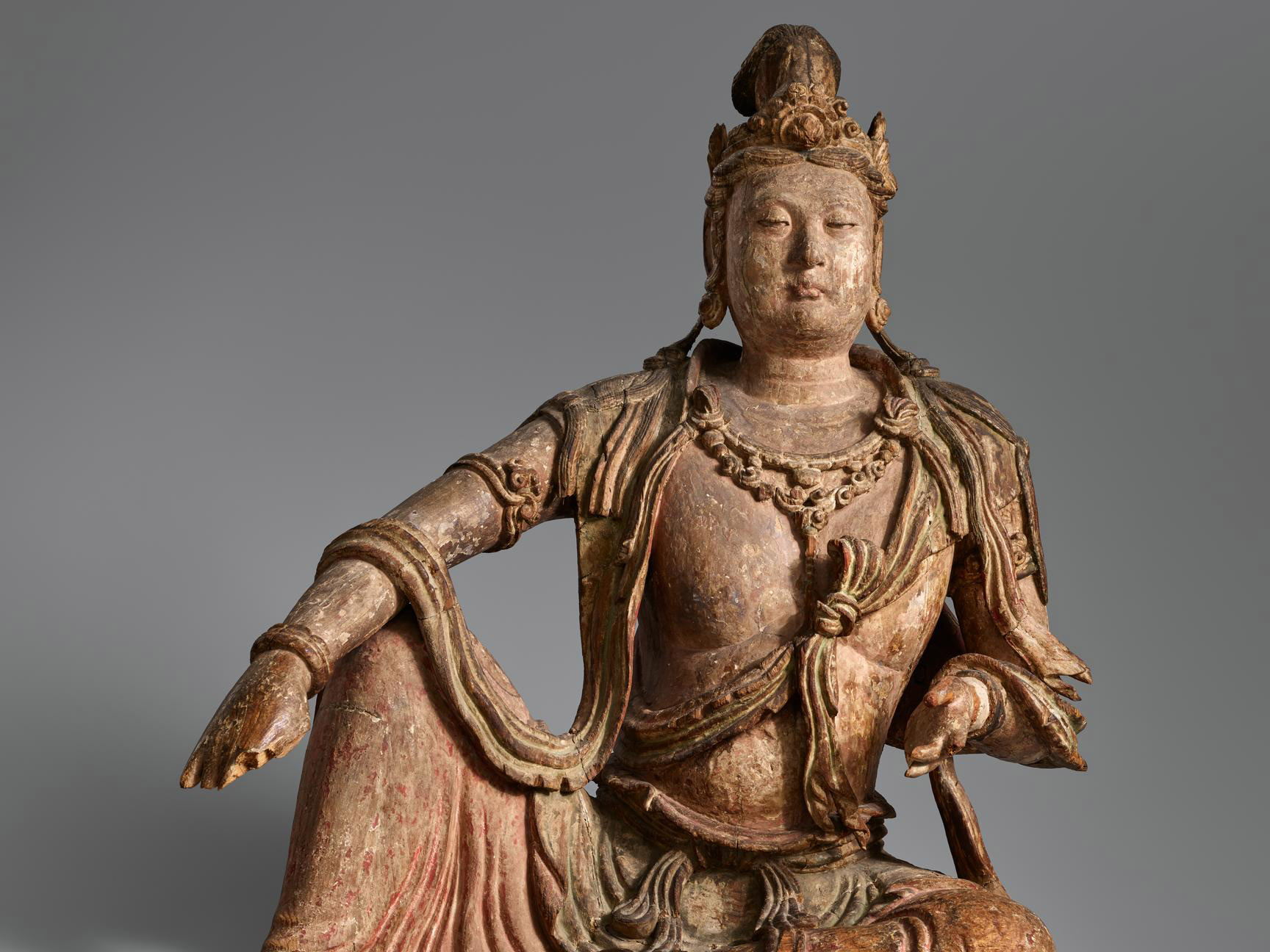Planned closure: Museum opens at 12 pm on Mon, Jan 19 due to a planned PG&E outage.
Planned closure: Museum opens at 12 pm on Mon, Jan 19 due to a planned PG&E outage.
This 1,000-year-old bodhisattva of compassion is a remarkable example of Song dynasty wood sculpture.

The bodhisattva Avalokiteshvara (Guanyin)
1100–1200
China; Song dynasty (960–1279)
Wood (paulownia) with pigments
The Avery Brundage Collection, B60S24+
Nearly 1,000 years old, this statue is a remarkable example of Buddhist sculpture from the Song dynasty, when wood replaced stone as the most commonly used medium. The Water-Moon Avalokiteshvara is a bodhisattva of compassion. His Chinese name, Shuiyue Guanyin, refers to his pose, seated in contemplation of the moon’s reflection on the water (shuiyue), and his nature, attuned to the sounds of the world (guanyin). His benevolence and often gentle appearance make Guanyin one of the most popular deities in China.

The bodhisattva Avalokiteshvara has long been a focus of devotion in East Asia. This deity vowed to liberate all creatures in the universe from pain and suffering and therefore deferred his enlightenment to achieve buddhahood. People from all walks of life seek help and blessings from him, not only because of his tremendous mercy and his ability to save devotees, but also because he is considered more approachable than the Buddha.
This 1,000-year-old Avalokiteshvara statue is a remarkable example of wooden Buddhist sculpture of China’s Song-Yuan period (960–1368), which is admired for sensitive carving and lifelike appearance.
Seated in the pose of “royal ease,” with right hand resting on bent knee, this deity is known as the “Water-Moon Guanyin” (Shuiyue Guanyin). He was thought to reside on an isolated isle named Potalaka in the mythical South Sea, where he sat and contemplated the moon’s reflection in the water. The reflection refers to the Buddhist concept that everything in the world around us is ephemeral and illusory, and Guanyin has the ability to hear all the world’s suffering.
Here, Avalokiteshvara is dressed as an Indian prince in a fluid garment with crossed sashes, scarves, and a necklace on his bare chest. He rests one hand on his knee and lifts the other in a gift-granting gesture. Showing a confident calmness, this deity fluidly presents his mercy over the suffering of humans and efficaciously consoles the souls of his devotees.
Of his 33 manifestations, Guanyin in his Water-Moon form is one of the most frequently represented by Chinese artists. His benevolence and often gentle appearance make Guanyin one of the most popular deities in China.
Beginning in the ninth century, Chinese images of Avalokiteshvara assumed an ambiguous gender identity. This development coincides with Buddhist texts in which bodhisattvas demonstrate the constructed nature of their gender by magically transforming it. Both Buddhist and Daoist devotees in traditional societies worshiped Avalokiteshvara as a goddess who might assist them, especially when they wished to bear sons and have a prosperous family. It was widely believed that this benign deity offered special protection to women, children, and sailors.
Guanyin has many representations. Beginning in the middle of the Tang dynasty (618–907), portrayals of Guanyin often included delicate, soft modeling of his face, torso, and hands, leading to the bodhisattva being perceived of as female. Over time, features associated with masculinity, like a mustache, were no longer depicted, and by the Yuan dynasty (1271–1368) a female form of the bodhisattva became popular. In China, a form of Guanyin known as the “giver of sons” came to be worshiped by mothers and hopeful mothers.
This Guanyin likely once sat on a rocky base surrounded by richly illustrated murals and gilded statues on an altar at a Buddhist monastery. The integration of architecture, painting, and sculpture in these monasteries achieved new heights in the history of Chinese Buddhist art.
Guanyin’s Original Sacred Surroundings
Few temples from this time in China (approx. 1100–1200) survive, but cave sites from later time periods may provide an idea of the original context of this wooden sculpture. It might once have been resting on a rock-like altar shelf, colorfully painted, and surrounded by other imagery. The integration of architecture, wall painting, and sculpture into the visual and ceremonial programs of monasteries characterized a new height of Buddhist art in middle-period China.
A storage space at the back of this statue (called zhuangzang) was created to store consecration materials, such as sutras and coins. Its original rectangular lid is missing. The holes under the base may have been cut to reduce the likelihood that the wood would crack or to lower the sculpture’s total weight.
Although it had been heavily repaired, this wooden statue has survived nearly a thousand years. The figure’s arms and legs are joined to the torso with wooden pegs and ancient and modern nails. Through recent examination of the red, green, and white pigments on the statue, conservators have concluded that it was also painted multiple times throughout its lifespan. Questions about this object remain and research continues.